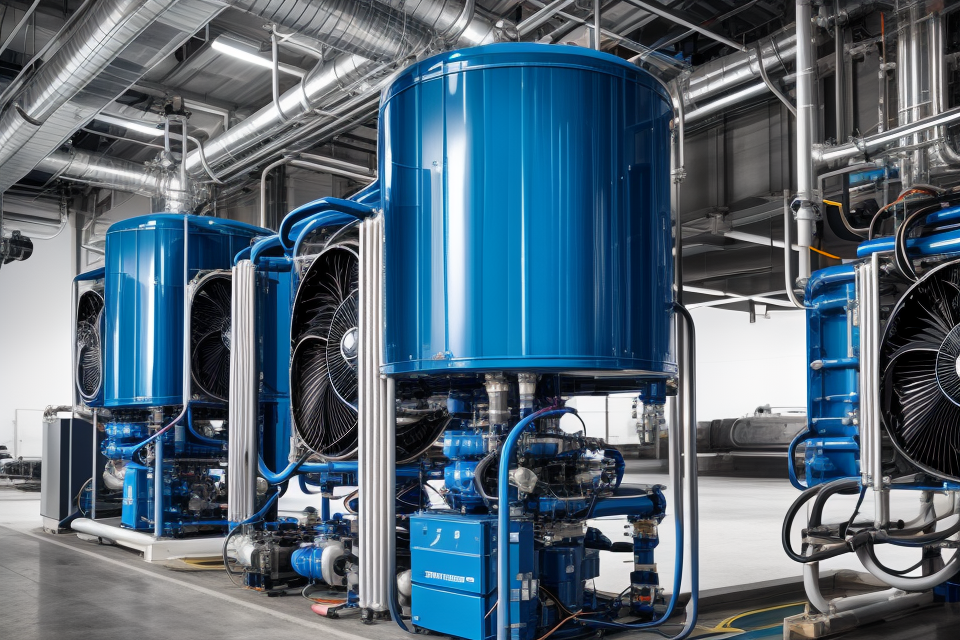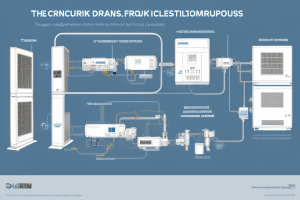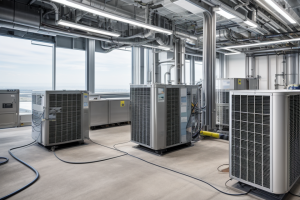
Cooling systems are an essential component of modern technology, designed to regulate the temperature of electronic devices and machinery. With the increasing demand for efficient and reliable cooling systems, it is crucial to understand the different types of cooling systems and their unique requirements. In this article, we will explore the three types of cooling systems – air cooling, liquid cooling, and passive cooling – and their specific features that make them suitable for different applications. From the thermodynamic principles that govern each system to the pros and cons of each design, this article will provide a comprehensive overview of the world of cooling systems.
Cooling systems can be classified into three main types based on their unique requirements: air-cooled, water-cooled, and air-to-air heat exchangers. Air-cooled systems rely on the movement of air to dissipate heat from the system. These systems are commonly used in small electronics and machinery where space is limited. The unique requirement for air-cooled systems is a source of clean, dry air and proper airflow through the system.
Water-cooled systems, on the other hand, rely on the circulation of water to transfer heat from the system. These systems are commonly used in larger applications such as industrial machinery and data centers. The unique requirement for water-cooled systems is a reliable supply of clean water and a method for removing heat from the system.
Air-to-air heat exchangers use the exchange of air to transfer heat from one system to another. These systems are commonly used in large commercial and industrial applications where heat recovery is desired. The unique requirement for air-to-air heat exchangers is a source of clean, dry air and proper airflow through the system. Additionally, these systems require careful design and maintenance to ensure optimal performance and prevent damage to the system.
H2: Types of Cooling Systems
H3: Air Cooling Systems
Air cooling systems are a popular choice for cooling computer components, especially for CPUs and other chips. In this section, we will discuss the description, unique requirements, and advantages and disadvantages of air cooling systems.
Description of Air Cooling Systems:
Air cooling systems are designed to cool the computer components by using the natural heat dissipation process of the air. The system includes a heatsink, a fan, and a thermal paste. The heatsink is a metal component that comes in contact with the CPU or other components, and it has a series of fins that increase the surface area for heat dissipation. The fan is responsible for pushing air over the heatsink, which helps to remove the heat from the system. The thermal paste is applied between the CPU and the heatsink to improve the thermal conductivity between the two components.
Unique Requirements for Air Cooling Systems:
Air cooling systems have a few unique requirements that need to be considered when choosing the right cooling solution for your computer. Firstly, the system requires adequate airflow to function effectively. If the airflow is restricted, the system may not be able to dissipate the heat efficiently, which can lead to overheating and damage to the components. Secondly, the system requires a power source to operate the fan, which can be connected to the motherboard or through a separate power cable. Lastly, the system requires regular maintenance, such as cleaning the fan and checking the thermal paste, to ensure optimal performance.
Advantages and Disadvantages of Air Cooling Systems:
Air cooling systems have several advantages and disadvantages that need to be considered before choosing the right cooling solution for your computer. One of the main advantages of air cooling systems is their affordability compared to other cooling solutions, such as liquid cooling systems. Additionally, air cooling systems are relatively easy to install and require minimal maintenance. However, one of the main disadvantages of air cooling systems is their noise level, as the fan can be quite loud, especially at high speeds. Additionally, air cooling systems may not be as effective as other cooling solutions in extreme conditions, such as overclocking or high-performance gaming.
H3: Water Cooling Systems
Water cooling systems are a type of cooling system that utilizes water to cool the components of a device or machine. This type of cooling system is commonly used in high-performance computing systems, data centers, and other applications where efficient heat dissipation is critical.
Unique Requirements for Water Cooling Systems
Water cooling systems have several unique requirements that must be met in order to ensure optimal performance and longevity. These requirements include:
- Clean and purified water: Water cooling systems require clean and purified water to prevent mineral buildup and corrosion of components.
- Proper water flow: Water cooling systems require a consistent and appropriate flow rate of water to ensure that all components are adequately cooled.
- Maintenance: Water cooling systems require regular maintenance, including cleaning and replacement of components, to prevent buildup of minerals and debris.
Advantages and Disadvantages of Water Cooling Systems
Water cooling systems offer several advantages over other types of cooling systems, including:
- Efficient heat dissipation: Water cooling systems are highly effective at dissipating heat, making them ideal for high-performance computing systems and other applications where heat is a concern.
- Quiet operation: Water cooling systems are generally quieter than air cooling systems, making them a popular choice for home theaters and other noise-sensitive environments.
- Compact design: Water cooling systems can be designed to be highly compact, making them ideal for use in small spaces.
However, water cooling systems also have some disadvantages, including:
- Higher cost: Water cooling systems are generally more expensive to install and maintain than air cooling systems.
- Requires water treatment: Water cooling systems require regular maintenance to prevent mineral buildup and corrosion, which can add to the overall cost of ownership.
- Risk of leaks: Water cooling systems have a higher risk of leaks, which can damage components and require costly repairs.
H3: Liquid Cooling Systems
Liquid cooling systems are one of the three primary types of cooling systems used in electronic devices, including computers and data centers. In a liquid cooling system, a liquid coolant is used to remove heat from the components and transfer it to a heat exchanger, where it is dissipated.
Unique Requirements for Liquid Cooling Systems
Unlike air cooling systems, liquid cooling systems have specific requirements that must be met to ensure efficient heat transfer and safe operation. These requirements include:
- Compatibility with the components: The liquid cooling system must be compatible with the components it is cooling. This means that the liquid coolant must be compatible with the materials used in the components, and the cooling system must be designed to fit the specific dimensions and layout of the components.
- Pressure and flow rate: The liquid cooling system must maintain a certain pressure and flow rate to ensure efficient heat transfer. The pressure and flow rate are determined by the size and layout of the cooling system, as well as the heat output of the components.
- Temperature: The liquid cooling system must be designed to maintain a safe temperature range for the components. This is typically achieved by using a temperature control system, such as a thermostat, to regulate the temperature of the coolant.
- Maintenance: Liquid cooling systems require regular maintenance to ensure efficient operation and prevent damage to the components. This includes cleaning the cooling system and replacing the coolant periodically.
Advantages and Disadvantages of Liquid Cooling Systems
Liquid cooling systems offer several advantages over air cooling systems, including:
- Efficient heat transfer: Liquid cooling systems can transfer heat more efficiently than air cooling systems, making them better suited for high-performance computing applications.
- Quiet operation: Liquid cooling systems are generally quieter than air cooling systems, making them ideal for use in noise-sensitive environments.
- Flexible layout: Liquid cooling systems can be designed to fit a wide range of component layouts, making them suitable for use in a variety of electronic devices.
However, liquid cooling systems also have some disadvantages, including:
- Complexity: Liquid cooling systems are generally more complex than air cooling systems, making them more difficult to install and maintain.
- Cost: Liquid cooling systems can be more expensive than air cooling systems, both in terms of the initial cost and the ongoing maintenance costs.
- Risk of leakage: Liquid cooling systems carry a risk of leakage, which can damage the components and require costly repairs.
H2: Choosing the Right Cooling System
H3: Factors to Consider
When selecting the right cooling system for your application, there are several factors to consider. These include:
- System size and layout: The size and layout of the system will depend on the specific needs of your application. For example, a large industrial facility may require a much larger cooling system than a small office building. Additionally, the layout of the building or facility may impact the type of cooling system that is most appropriate.
- Cost and budget: The cost of the cooling system will depend on several factors, including the size of the system, the type of system, and the specific requirements of your application. It is important to consider the total cost of ownership, including installation, operation, and maintenance costs, when selecting a cooling system.
- Maintenance and repair requirements: Different cooling systems have different maintenance and repair requirements. For example, a water-cooled system may require more frequent maintenance than an air-cooled system. It is important to consider the maintenance and repair requirements of the system when selecting a cooling system.
- Environmental factors: The environmental impact of the cooling system should also be considered. For example, some cooling systems may have a greater impact on the environment than others. It is important to consider the environmental impact of the system when selecting a cooling system.
H3: Pros and Cons of Each Type
When choosing a cooling system for your application, it’s important to consider the pros and cons of each type. Here’s a summary of the advantages and disadvantages of each type of cooling system:
1. Air-Cooled Systems
Pros:
- Simple and cost-effective
- Can be used in a variety of applications
- Easy to install and maintain
Cons:
- Require a significant amount of space for installation
- Generate a lot of noise
- Can be prone to dust and debris buildup
2. Water-Cooled Systems
- Higher efficiency than air-cooled systems
- Require less space for installation
-
Generate less noise
-
More complex and expensive than air-cooled systems
- Require regular maintenance to prevent corrosion and blockages
- Can be prone to leaks
3. Air- and Water-Cooled Systems
- Can be customized to meet specific requirements
-
High efficiency
-
More complex and expensive than other types of systems
When deciding which type of cooling system is right for your application, it’s important to consider factors such as cost, space requirements, noise level, efficiency, and maintenance requirements. By weighing the pros and cons of each type of system, you can make an informed decision that meets your specific needs.
FAQs
1. What are the three types of cooling systems?
Answer:
The three types of cooling systems are air-cooled, water-cooled, and air/water-cooled.
2. What is an air-cooled cooling system?
An air-cooled cooling system uses air to cool the heat-generating components of a system. It typically consists of a fan or blower that pulls air over the hot components, which then dissipates the heat into the surrounding environment. Air-cooled systems are commonly used in smaller or less power-dense applications where water-cooled systems may not be practical.
3. What is a water-cooled cooling system?
A water-cooled cooling system uses water to cool the heat-generating components of a system. The water is pumped through a closed-loop system that includes a radiator or heat exchanger, where the heat is dissipated into the surrounding environment. Water-cooled systems are commonly used in larger or more power-dense applications where air-cooled systems may not be sufficient to dissipate the heat generated.
4. What is an air/water-cooled cooling system?
An air/water-cooled cooling system combines the advantages of both air-cooled and water-cooled systems. The system uses air to cool the heat-generating components up to a certain temperature, after which the water is used to cool the remaining heat. This type of system is commonly used in applications where there is a need for both efficient cooling and a compact design.
5. What are the unique requirements for each type of cooling system?
The unique requirements for each type of cooling system depend on the specific application and the heat-generating components being cooled. In general, air-cooled systems are suitable for smaller or less power-dense applications, while water-cooled systems are suitable for larger or more power-dense applications. Air/water-cooled systems are suitable for applications where there is a need for both efficient cooling and a compact design. The specific requirements for each type of system, such as coolant type, flow rate, and temperature, must be carefully considered and designed for the specific application to ensure optimal performance and reliability.







